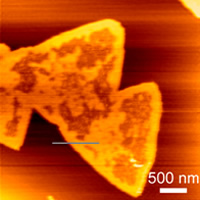Research highlights
Cell repair mechanisms: Substrate-induced phase separation in ganglioside GM1-containing supported lipid bilayers
Ganglioside GM1 (GM1), a glycosphingolipid responsible for neuronal plasticity and repair mechanism, works as a seed for the polymerization of amyloid β (Aβ) peptide, which is regarded as one of fundamental processes of Alzheimer's disease.
However, lateral organization of GM1 molecules in cell membranes, such as molecular clustering and domain formation, is still unclear.
Here, Ryugo Tero at the Electronics-Inspired Interdisciplinary Research Institute (EIIRIS) in collaboration with Yanli Mao and other colleagues at Institute for Molecular Science found unique phase separation forming triangular domains to occur in a supported lipid bilayer (SLB) consisting of GM1, sphingomyelin (SM) and cholesterol (Chol) at 20:40:40 molar ratio (Fig.1).
The GM1+SM+Chol-SLB was prepared on mica and SiO2/Si(100) surfaces by vesicle fusion method, where the substrate was immersed at the GM1+SM+Chol-vesicle (=liposome) suspension at 70ºC, and the adsorbed vesicles on the substrate surface spontaneously transformed to SLB. The SLB was again incubated at 37ºC for 24 h and observed by using atomic force microscope (AFM).
Triangular domains appeared only on mica surface, not on SiO2/Si(100), and all triangles were in the same direction, therefore the phase separation was induced by the SLB-mica interaction. Cholera toxin B-subunit (CTXB) assay to GM1 revealed GM1 to localize at the region out of the triangular domains. The researchers also found that the GM1+SM+Chol-SLB on mica was highly active for Aβ-polymerization.
These results open the possibility that solid surface functions may be used to control the biological activity of artificial bilayer membranes in vitro as well as their structures.
- Reference:
- Yanli Maoa, b, 1, Zhiguo Shangc,1 Yosuke Imaid, Tyuji Hoshinod, Ryugo Teroa*, c, Motohiko Tanakac, e, Naoki Yamamotof, g, Katsuhiko Yanagisawag and Tsuneo Urisua, c, h,
- Surface-induced phase separation of a sphingomyelin/cholesterol/ganglioside GM1-planar bilayer on mica surfaces and microdomain molecular conformation that accelerates Aβ oligomerization
- Biochimica et Biophysica Acta 1798, 1090 (2010)
- aInstitute for Molecular Science, Myodaiji, Okazaki 444-8585, Japan; bInstitute of Optics and Photoelectronic Technology, Henan University, Kaifeng 475001, China; cGraduate University for Advanced Studies, Myodaiji, Okazaki 444-8585, Japan; dDepartment of Physical Chemistry, Chiba University, Chiba 263-8522, Japan; eNational Institute for Fusion Science, Toki 509-5292, Japan; fDepartment of Pharmacy, College of Pharmaceutical Sciences, Ritsumeikan University, Noji, Higashi, Kusatsu, Shiga 525-8577, Japan; gDepartment of Alzheimer's Disease Research, National Institute for Longevity Sciences, National Center for Geriatrics and Gerontology, Obu 474-8522, Japan; hJST, CREST, Institute for Molecular Science, Myodaiji, Okazaki 444-8585, Japan
- DOI:10.1016/j.bbamem.2010.03.003
- *Ryugo Tero is now at the Electronics-Inspired Interdisciplinary Research Institute (EIIRIS), Toyohashi University of Technology.
- Related websites
- Electronics-Inspired Interdisciplinary Research Institute (EIIRIS): http://www.eiiris.tut.ac.jp/

Dr Tero

Fig.1: AFM topograph of the triangular domains GM1+SM+Chol-SLB on a mica surface.

